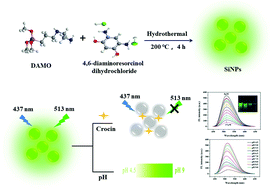Green-emitting silicon nanoparticles as a fluorescent probe for highly-sensitive crocin detection and pH sensing†
Abstract
Crocin, the main component of the gardenia yellow pigment, is a rare natural water-soluble carotenoid that is effective in treating many diseases owing to its excellent anti-oxidant properties. Developing simple methods for the sensitive detection of crocin is thus of great significance. In this study, green fluorescent silicon nanoparticles (SiNPs) with good water dispersibility were synthesized via a one-pot hydrothermal method by using N-[3-(trimethoxysilyl)propyl]-ethylenediamine (DAMO) as a silicon source and 4,6-diaminoresorcinol dihydrochloride as a reducing agent. Under excitation at 437 nm, the SiNPs emitted bright green fluorescence at 513 nm. The SiNPs revealed robust photo-stability, as well as excellent salt and temperature stability. Interestingly, the fluorescence of the SiNPs was positively sensitive to the solution pH, making them a promising probe for pH sensing. Moreover, the fluorescence of the SiNPs could be dramatically quenched by crocin. Employing the SiNPs as a fluorescent probe, a novel fluorescence method for the accurate and quantitative detection of crocin was established with a linear range of 0.01–17 μM and a limit of detection (LOD) of 3.3 nM. In addition, the quenching mechanism was also discussed. The proposed method was successfully utilized for the accurate detection of the gardenia yellow pigment in three traditional Chinese herbs. In addition, a paper sensor based on the SiNPs was also developed for rapid and convenient detection of crocin by the naked eye.



 Please wait while we load your content...
Please wait while we load your content...